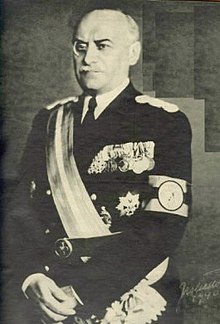Ion Gigurtu
Ion Gigurtu | |
|---|---|
 | |
| Prime Minister of Romania | |
| In office 4 July 1940 – 5 September 1940 | |
| Monarch | Carol II |
| Preceded by | Gheorghe Tătărescu |
| Succeeded by | Ion Antonescu |
| Personal details | |
| Born | 24 June 1886 National Agrarian Party (1932-1935) National Christian Party (1935-1938) National Renaissance Front (1938-1940) Party of the Nation (1940) |
| Profession | Officer, industrialist |
| Military service | |
| Allegiance | Kingdom of Romania |
| Branch/service | Romanian Land Forces |
| Battles/wars | Second Balkan War World War I World War II |
Ion Gigurtu (Romanian pronunciation:
Gigurtu's executive was primarily noted for realizing the inability of
Biography
Early life
Born in
Joining
Gigurtu, as a "pro-
Rise to power

Following his imposition of a royal dictatorship, Carol II reconfirmed Gigurtu as a member of the Superior Economic Council in April 1938. He then made him
The king turned to Gigurtu to be his next prime minister—he was by then a wealthy industrialist who, aside from being a committed
Policies, loss of Northern Transylvania and downfall
After his appointment, Gigurtu announced he would work to integrate Romania into the Axis sphere, taking a series of steps in that direction: withdrawal from the
From late June to mid-July, the king exchanged several letters with Hitler who, using an ultimatum-like tone, demanded that Carol make territorial concessions to Hungary and
Following numerous protests against what was popularly labelled the "Vienna Diktat", Gigurtu's cabinet resigned on September 4, replaced within a few days by the monarch's rival Ion Antonescu.[21] The Iron Guard, which had been plotting a coup d'état against Carol after September 3, negotiated a partnership with Antonescu, setting up the fascist-inspired National Legionary State (which was to crumble during Sima's 1941 rebellion).[22] Reportedly, Gigurtu's decision to resign had been taken after the infuriated king told him to execute fifteen arrested Guardists, therefore aiding the rapprochement between Carol's opponents.[23]
Final years, arrests and death
Gigurtu stayed in Romania for the remainder of
Finally, on the night of May 5–6, 1950, Gigurtu was arrested, together with other former dignitaries of the monarchical period, and sent to Sighet Prison. In the summer of 1956, most surviving political detainees were freed, except for former prime ministers, justice ministers, and interior ministers, who were accused of "intense activity against the working class". Gigurtu had been held without trial at Sighet for nearly six years, but was finally judged in a public show trial and sentenced to fifteen years' imprisonment. His appeal was rejected, and three years later, gravely ill and in serious pain, he died in the penitentiary at Râmnicu Sărat.[24] Gigurtu was rehabilitated by the Romanian Supreme Court in 1999.[25][26][27]
Essays
- Dezvoltarea industriei în România ("The Development of Industry in Romania", 1916)
- Posibilitățile de refacere și dezvoltare a industriei în România ("Prospects for the Reconstruction and Development of Industry in Romania", 1918)
- Industria mecanică metalurgică. Studiu economico-statistic ("The Mechanical Metalworking Industry. An Economic and Statistical Study")
- Politica minieră a Statului cu privire la exploatațiile metalifere ("The State's Mining Policy in Respect to Metalworking Sites", 1931)
Notes
- ^ a b c d Neagoe, p.325
- ^ (in Romanian) Bălcescu, Barbu Archived 2011-09-03 at the Wayback Machine at the site of the Alexandru and Aristia Aman Dolj County Library
- ^ a b c d e f Neagoe, p.326
- ^ Nicolescu, p.162
- ISBN 9781461694908
- ^ Neagoe, p.326; Nicolescu, p.162
- ISBN 0-8047-0870-3
- ^ Deletant, p.23; Neagoe, p.326; Nicolescu, p.162-163
- ^ a b c Nicolescu, p.163
- ^ Deletant, p.51, 56, 293; Nicolescu, p.163; Ornea, p.325
- ^ Deletant, p.51, 293
- ^ Ornea, p.325, 330
- ^ Nicolescu, p.163; Ornea, p.392
- ^ Ornea, p.392
- ^ Deletant, p.103; Ornea, p.392-393
- ^ Deletant, p.103
- ^ Deletant, p.103; Ornea, p.392
- ^ Jonathan C. Friedman, Taylor & Francis, 2010, The Routledge History of the Holocaust, p. 279
- ^ Deletant, p.23
- ^ Nicolescu, p.163-164
- ^ Deletant, p.48sqq; Nicolescu, p.164; Ornea, p.325-328
- ^ Deletant, p.48sqq; Ornea, p.325sqq
- ^ Deletant, p.48
- ^ a b Neagoe, p.327
- ^ Martin Jung, Frank & Timme GmbH, 2016, In Freiheit: Die Auseinandersetzung mit Zeitgeschichte in Rumänien (1989 bis 2009), p. 245
- ^ Wolfgang Benz, Brigitte Mihok, Metropol Verlag, 2009, Holocaust an der Peripherie: Judenpolitik und Judenmord in Rumänien und Transnistrien 1940-1944, pp. 204 and 207
- ^ Eduard Nižňanský, Univerzita Komenského v Bratislave. Filozofická fakulta, Stimul, 2007, Z dejín Holokaustu a jeho popierania, p. 164
References
- ISBN 1-4039-9341-6
- Stelian Neagoe, Oameni politici români, Editura Machiavelli, Bucharest, 2007. ISBN 973-99321-7-7
- Nicolae Nicolescu, Enciclopedia șefilor de guvern ai României, Editura Meronia, Bucharest, 2006. ISBN 973-7839-09-9
- ISBN 973-9155-43-X
